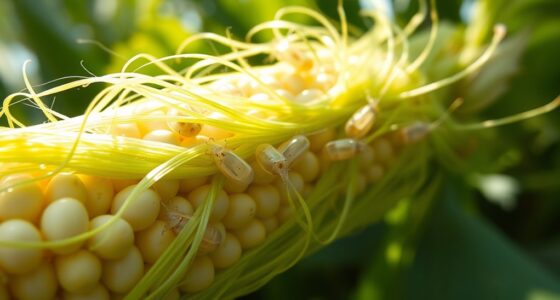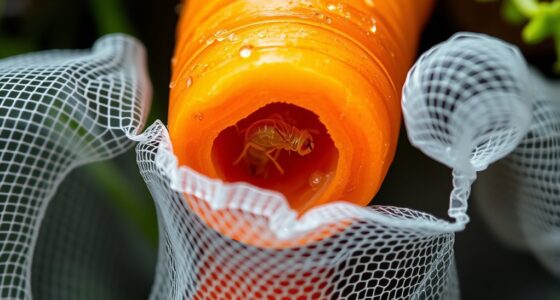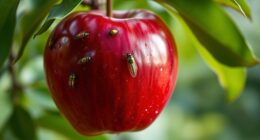Using trap crops to manage cucumber beetles involves planting attractant plants like squash or pumpkins near your main crops to divert beetles away. These crops lure beetles, reducing damage to your main plants, and can be combined with regular monitoring and removal to improve control. Proper timing and placement are key to success. Keep exploring strategies to make your pest management more sustainable and effective.
Key Takeaways
- Select attractant plants like squash, pumpkins, or cucurbits planted early near main crops to lure cucumber beetles away.
- Position trap crops strategically along field edges or in clusters to maximize beetle attraction.
- Monitor trap crops daily, removing heavily infested plants promptly to prevent beetle spread.
- Rotate trap crops annually and combine with other control methods like beneficial insects for sustainable management.
- Use physical barriers or covers alongside trap cropping to enhance protection of the main crops.
Understanding the Behavior of Cucumber Beetles
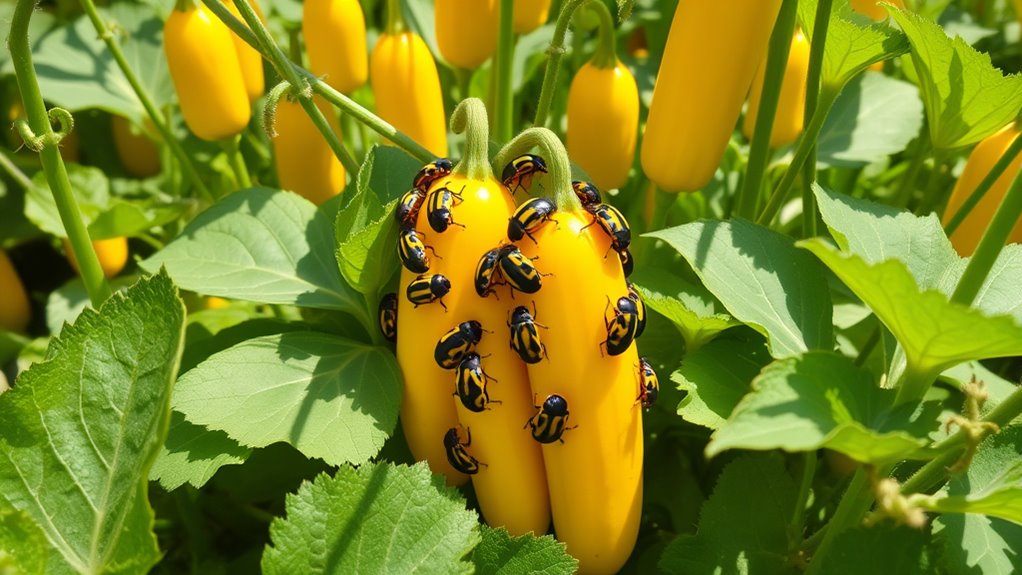
To effectively manage cucumber beetles, you need to understand how they behave. Cucumber beetle biology reveals that these pests are highly mobile and attracted to host plants like cucumbers, squash, and pumpkins. Their pest behavior patterns include active daytime feeding and mating, with adults often moving between plants to find food and mates. They are notorious for laying eggs on plant leaves and stems, which hatch into larvae that damage roots. Knowing that these beetles prefer warm weather and are sensitive to plant signals helps you anticipate their movements. They tend to stay close to their food sources, but can quickly spread across your garden. Recognizing these key behaviors allows you to develop targeted management strategies, such as trap cropping, to effectively reduce their impact. Additionally, understanding their feeding habits can help you time your interventions for maximum effectiveness.
Benefits of Using Trap Crops in Pest Management
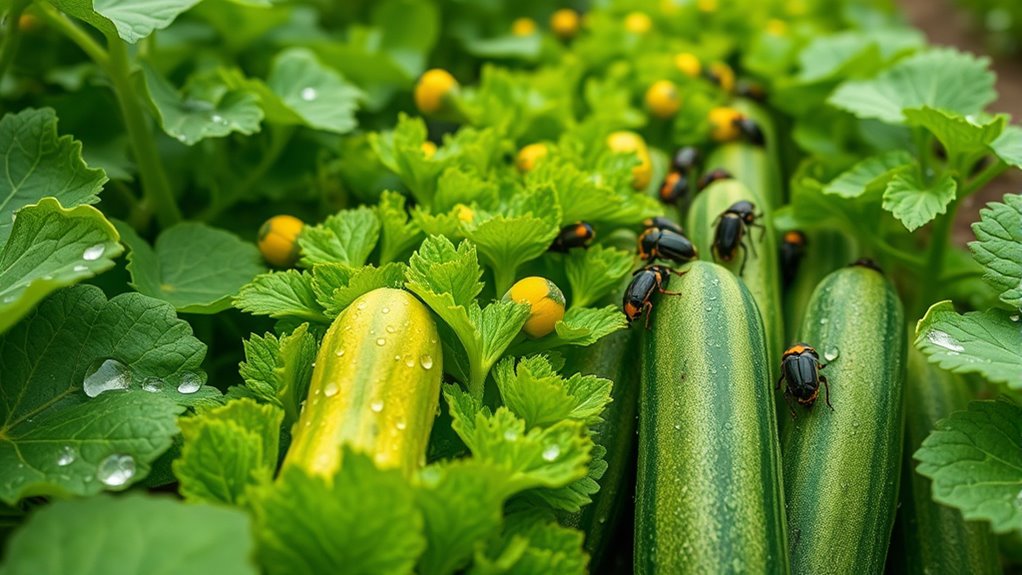
Using trap crops offers several advantages in managing cucumber beetles effectively. One key benefit is reducing the economic impact on your garden or farm by minimizing crop damage and lowering the need for chemical controls. Trap crops attract beetles away from your main crops, decreasing pest populations naturally. This approach also helps maintain ecological balance by promoting beneficial insects and reducing pesticide use. By focusing beetles on specific plants, you can control infestations more efficiently and prevent widespread damage. Additionally, trap cropping can enhance overall plant health and yield. With fewer chemicals needed, you support a healthier environment and promote sustainable pest management practices. Overall, using trap crops provides a cost-effective, environmentally friendly method to manage cucumber beetles while protecting your crops. High refresh rates also contribute to more efficient pest monitoring and quick response times.
Selecting the Most Effective Trap Crops for Cucumber Beetles
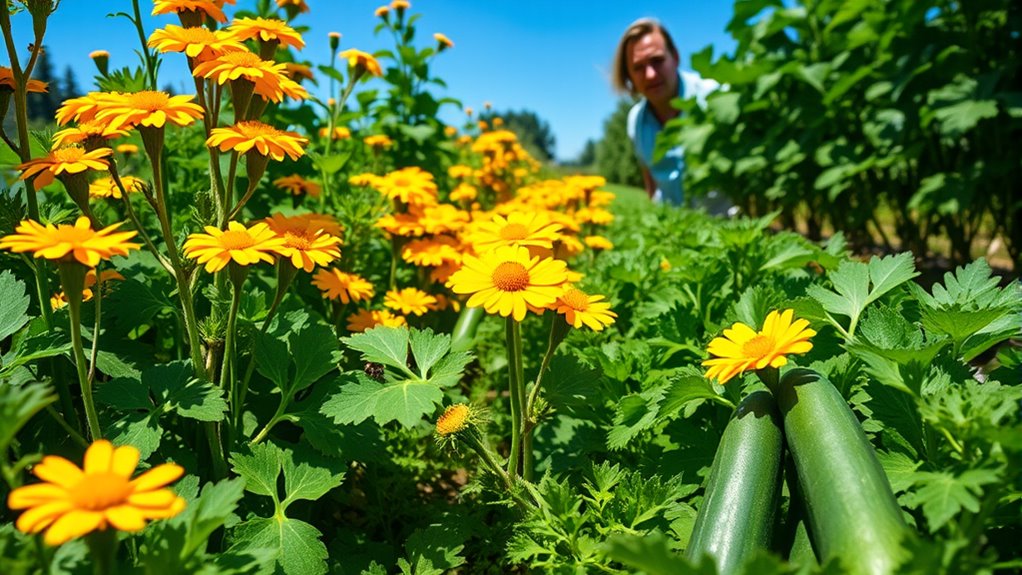
Choosing the right trap crops depends on understanding which attractant plants lure cucumber beetles most effectively. You should also consider the timing and placement to guarantee beetles are drawn away from your main crops. Additionally, selecting companion plants that support trap crops can enhance their effectiveness and benefit your garden overall. Incorporating integrated pest management strategies can further improve your control efforts and promote a healthy garden ecosystem.
Attractant Plant Types
Selecting the right trap crops is crucial for effectively attracting cucumber beetles away from your main crops. To do this, focus on attractant plant types that appeal to beetle senses. Scent-based lures are especially effective in drawing beetles to trap crops. Consider these options:
- Squash and Pumpkins – Known for their strong scent, they attract cucumber beetles quickly.
- Sweet Potatoes – Their aroma acts as a powerful lure for beetles seeking hosts.
- Cucurbits (Melons, Cucumbers) – These produce scent signals that beetles find irresistible.
Choosing plants with potent scent-based lures helps ensure beetles are drawn to your trap crops first, reducing pressure on your main crops. Accurate selection of attractant plant types maximizes trap crop effectiveness.
Timing and Placement
Timing and placement are key to maximizing the effectiveness of your trap crops. Plant trap crops early, before cucumber beetles become active, to attract them away from your main crops. Position trap crops near the field edges or in strategic locations where beetles are most likely to land. Proper placement guarantees beetles are drawn away from your vegetables, reducing pest pressure. Incorporate crop rotation practices to prevent beetles from becoming established in the soil, maintaining soil health and disrupting their life cycle. Avoid planting trap crops too late, as beetles may already infest your main crops. Consistent monitoring helps you determine the best timing for placement, ensuring beetles are attracted when they’re most active, which enhances the trap crop’s effectiveness in protecting your vegetables. Additionally, selecting a suitable location for planting trap crops can significantly improve their ability to intercept beetles before they reach your main crops.
Companion Plant Benefits
When it comes to managing cucumber beetles with trap crops, understanding the benefits of companion planting can make a significant difference. Selecting the right plants offers more than pest control; it enhances your garden’s health and productivity. Here are three key benefits:
- Pollinator Attraction: Certain trap crops attract beneficial pollinators, supporting your main crops’ fruit and flower development.
- Soil Enrichment: Some companion plants improve soil quality, increasing nutrient availability for neighboring vegetables.
- Enhanced Pest Management: Effective trap crops lure cucumber beetles away from your main plants, reducing damage and pesticide use.
Incorporating home furnishings, such as using protective covers or physical barriers, can further enhance your pest management strategy. Choosing the right companion plants maximizes these benefits, making your garden more resilient and productive while naturally managing pests.
Designing an Effective Trap Crop Layout
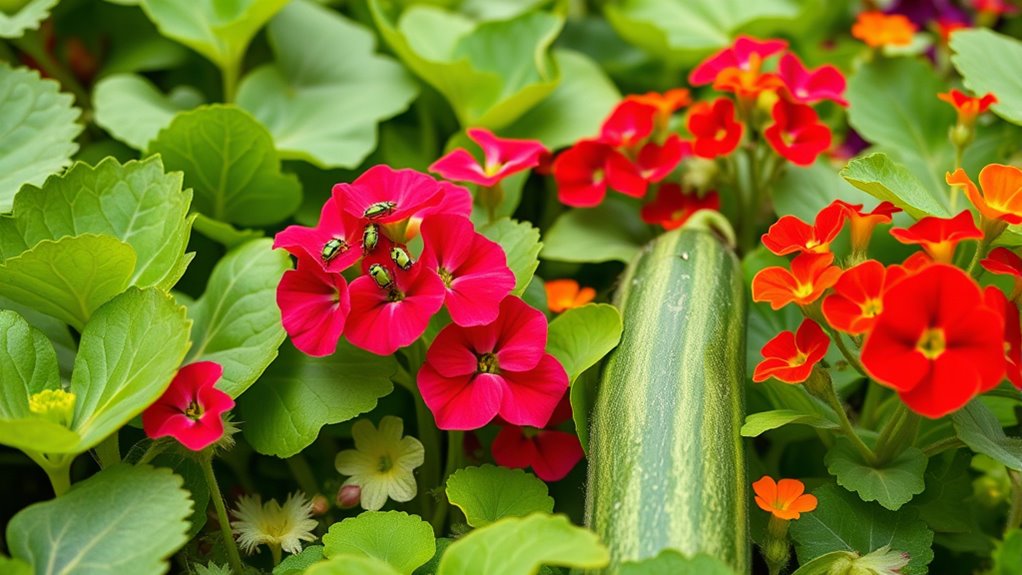
Creating an effective trap crop layout involves strategic placement to maximize beetle attraction and protect your main crop. Position trap crops where cucumber beetles are most likely to land, such as field edges or near entry points to your garden. Use crop rotation principles to avoid building beetle populations in the same area year after year, which can weaken soil health and increase pest issues. Plant trap crops in clusters or strips to draw beetles away from your main crop efficiently. Guarantee the trap crop is robust and healthy to attract maximum beetle activity. Properly planned placement not only enhances trap effectiveness but also supports soil health by reducing pest pressure and promoting a balanced ecosystem in your garden. Incorporating integrated pest management strategies can further improve trap crop success and reduce reliance on chemical controls.
Timing and Planting Strategies for Trap Cropping

Timing your plantings correctly guarantees your trap crop attracts cucumber beetles when they’re most active. You should consider planting your trap crops early or in sequence with your main crop to maximize their effectiveness. Planning these steps helps you reduce beetle pressure and protect your cucumbers.
Optimal Planting Periods
Selecting the right planting periods for trap crops is essential to effectively manage cucumber beetles. Timing ensures the trap crop attracts beetles before your main crop develops, reducing pest pressure. Consider these strategies: 1. Plant early in the season to target beetles before they reach your main crop. 2. Coordinate planting with crop rotation to maintain soil health and disrupt beetle life cycles. 3. Monitor pest activity closely and adjust planting dates accordingly for maximum attraction. Additionally, understanding the transformative power of decluttering can help gardeners create a more organized and efficient planting schedule, ensuring timely interventions and better pest management.
Sequential Crop Deployment
How can you optimize trap cropping effectiveness through sequential crop deployment? By carefully timing your plantings, you can disrupt cucumber beetle life cycles and improve soil health. Start with early-planted trap crops to attract beetles away from main crops. Then, rotate to different trap crops to prevent pest adaptation and maintain soil vitality. Proper timing ensures beetles are caught before they lay eggs, reducing population buildup. Use sequential planting strategies to keep pests off-balance and preserve crop health. Incorporating crop rotation practices also helps maintain soil health and disrupt pest reservoirs. Here’s a quick guide:
| Planting Stage | Purpose |
|---|---|
| Early season | Attract beetles early |
| Mid-season | Interrupt reproduction |
| Post-harvest | Reduce overwintering sites |
| Crop rotation | Maintain soil health, pest control |
Monitoring and Maintaining Trap Crops

To effectively manage cucumber beetles with trap crops, you need to regularly monitor them for signs of beetle activity and damage. Keep a close eye on pest levels and look for beetle presence or feeding damage. Regular monitoring helps you catch infestations early and respond quickly. Using monitoring techniques can further enhance your ability to detect early infestations and prevent widespread damage.
Here are three key steps:
- Check trap crops daily during peak beetle activity.
- Remove and destroy heavily infested plants to reduce trap crop pests.
- Rotate crops to disrupt beetle life cycles and prevent buildup.
Maintaining healthy trap crops involves timely removal, preventing pest buildup, and practicing crop rotation. These steps ensure the trap crop remains effective, reduces beetle populations, and supports sustainable pest management.
Integrating Trap Cropping With Other Pest Control Methods
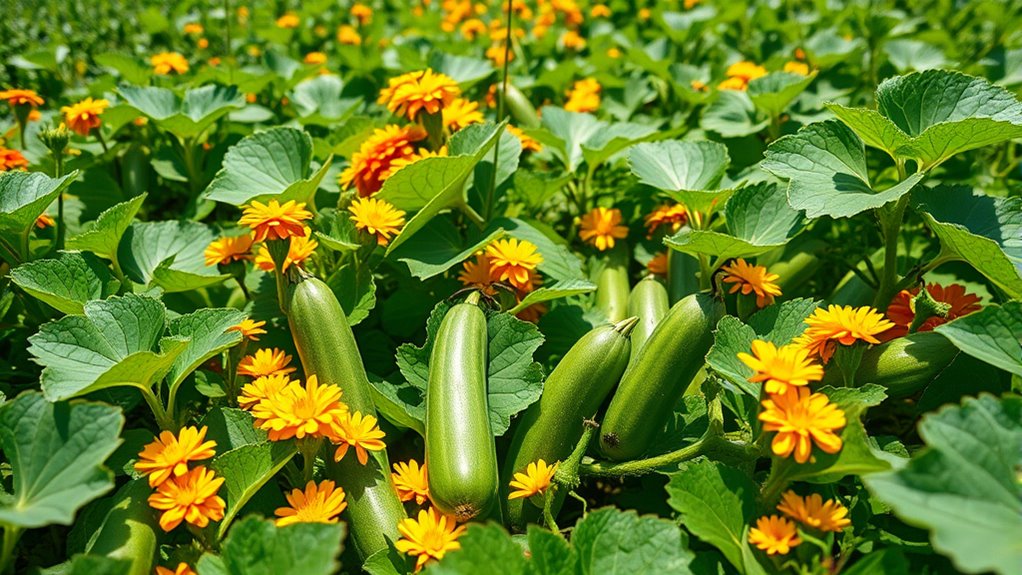
Integrating trap cropping with other pest control methods enhances the overall effectiveness of cucumber beetle management. Combining strategies like crop rotation and biological control can reduce beetle populations more efficiently. For instance, rotating crops disrupts beetle life cycles, preventing buildup in your fields. Biological control introduces natural enemies, such as beneficial nematodes or predatory insects, that target cucumber beetles. To visualize how these methods work together, consider this table:
| Method | Benefits | Implementation Tips |
|---|---|---|
| Crop Rotation | Breaks beetle life cycle, reduces infestation | Rotate cucurbits with non-host crops |
| Biological Control | Natural pest suppression, eco-friendly | Release predators or nematodes regularly |
| Trap Crops | Attract beetles, concentrate pests | Use alongside crop rotation and biological control |
Additionally, selecting effective trap crops can significantly increase pest attraction, making control efforts more efficient. Combining these methods provides a robust, sustainable approach to managing cucumber beetles.
Case Studies: Successful Trap Cropping Implementations

Numerous farmers have successfully used trap cropping to reduce cucumber beetle damage and improve crop yields. For example, one farm used marigolds as a trap crop alongside their cucumbers, markedly decreasing beetle populations. Here are some key strategies:
- Planting trap crops near main crops to attract beetles away from vegetables
- Using rainwater harvesting to irrigate trap crops sustainably and prevent soil erosion
- Timing trap crop planting to maximize beetle attraction and reduce pest spread
These implementations show that integrating trap crops with water management practices can boost effectiveness. By focusing on strategic placement and resource conservation, you can enhance pest control while protecting soil health and reducing erosion risks. Successful case studies highlight that well-planned trap cropping benefits both your yield and the environment.
Potential Challenges and How to Overcome Them

While trap cropping offers effective pest management, it also presents certain challenges that you need to anticipate and address. One issue is pest resistance, where cucumber beetles may adapt to the trap crops over time. To prevent this, rotate crops regularly and avoid relying solely on trap crops. Another challenge is managing beetle populations that may move beyond trap crops, potentially damaging main crops. Proper crop rotation helps disrupt beetle life cycles and reduces infestations. Additionally, maintaining trap crops requires consistent monitoring and timely removal of beetles. The table below summarizes key ideas:
| Challenge | Solution | Impact |
|---|---|---|
| Pest resistance | Rotate crops, diversify plants | Reduces beetle adaptation |
| Beetle migration | Use barrier plants or borders | Limits movement |
| Monitoring | Regular inspections | Detects infestations early |
| Trap crop management | Timely removal of pests | Prevents overpopulation |
Future Trends in Sustainable Cucumber Beetle Management
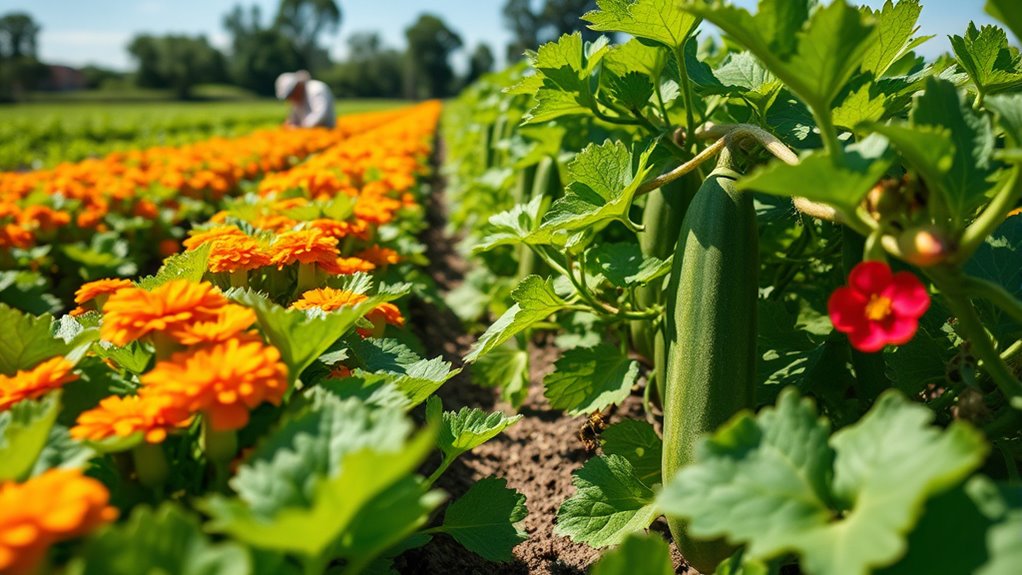
Advances in sustainable agriculture are shaping the future of cucumber beetle management by emphasizing environmentally friendly and integrated approaches. You can expect to see innovations that incorporate genetic modification to develop pest-resistant crops, reducing the need for chemical controls. Climate resilience also plays a critical role; crops designed to withstand changing weather patterns can better tolerate beetle pressure and environmental stresses. Future trends include:
- Genetic modification to enhance crop resistance and reduce pest attraction.
- Breeding climate-resilient varieties that adapt to changing conditions.
- Integrated pest management strategies combining trap crops with biological controls for sustainable results.
These developments aim to create resilient, eco-friendly solutions that protect your crops while promoting long-term sustainability and environmental health.
Frequently Asked Questions
How Do Trap Crops Affect Overall Garden Biodiversity?
Trap crops can positively influence your garden’s biodiversity by attracting pollinator interactions and enhancing habitat diversity. They create specific zones for pests, which reduces pressure on other plants, encouraging a variety of beneficial insects and pollinators. This not only helps manage pests naturally but also supports a balanced ecosystem, making your garden more resilient and thriving overall. Properly used, trap crops can be a valuable tool for sustainable gardening.
Are There Specific Cucumber Varieties More Resistant to Beetles?
Imagine stepping into a time machine—certain cucumber varieties show more resistance to beetle preferences, making your garden less of a beetle magnet. Some varieties, like ‘Marketmore 76’ or ‘Armenian,’ naturally resist beetle attacks better. While no cucumber is completely immune, choosing these resistant types can help reduce beetle damage, aiding your pest management efforts and making your garden more productive and resilient.
What Are the Economic Costs of Implementing Trap Cropping?
You should consider the cost analysis and financial feasibility of trap cropping before implementation. Trap cropping involves additional expenses for planting and maintaining extra crops, but it can reduce pesticide costs and crop losses. While initial investments may seem high, long-term savings and reduced chemical use can offset these costs. Evaluating your specific farm size and pest pressure helps determine if trap cropping is a cost-effective, sustainable pest management strategy for you.
Can Trap Crops Be Used Alongside Organic Pest Control Methods?
You might wonder if trap crops can work with organic pest control methods. The answer is yes, but trap crop compatibility depends on how well they integrate organically. When you use organic methods alongside trap crops, you create a powerful duo that reduces beetle populations naturally. Just make certain your chosen trap crops and organic techniques complement each other, maximizing pest control while maintaining your organic standards. This synergy can boost your garden’s health and yield.
How Long Does It Take to See Results From Trap Cropping?
You might wonder how long it takes to see results from trap cropping. Timing expectations vary, but typically, you’ll notice reduced pest damage within a week or two as cucumber beetles are attracted to the trap crops. Success indicators include fewer beetles on your main crops and increased beetle presence on the trap plants. Keep monitoring regularly to gauge effectiveness and adjust your strategy if needed for maximum pest control.
Conclusion
By using trap crops, you can turn your garden into an impenetrable fortress against cucumber beetles, stopping them dead in their tracks before they even reach your main crops. It’s like having an army of decoys that lure pests away and save your plants from total destruction. With the right strategy, you’ll be the hero of your garden, preventing catastrophe and ensuring bumper harvests—truly, it’s the ultimate game-changer in pest management!



